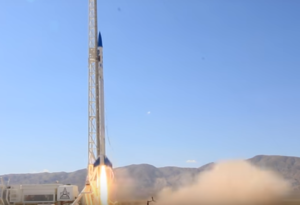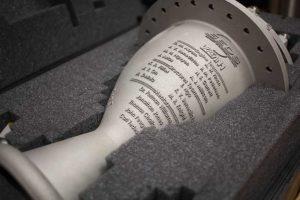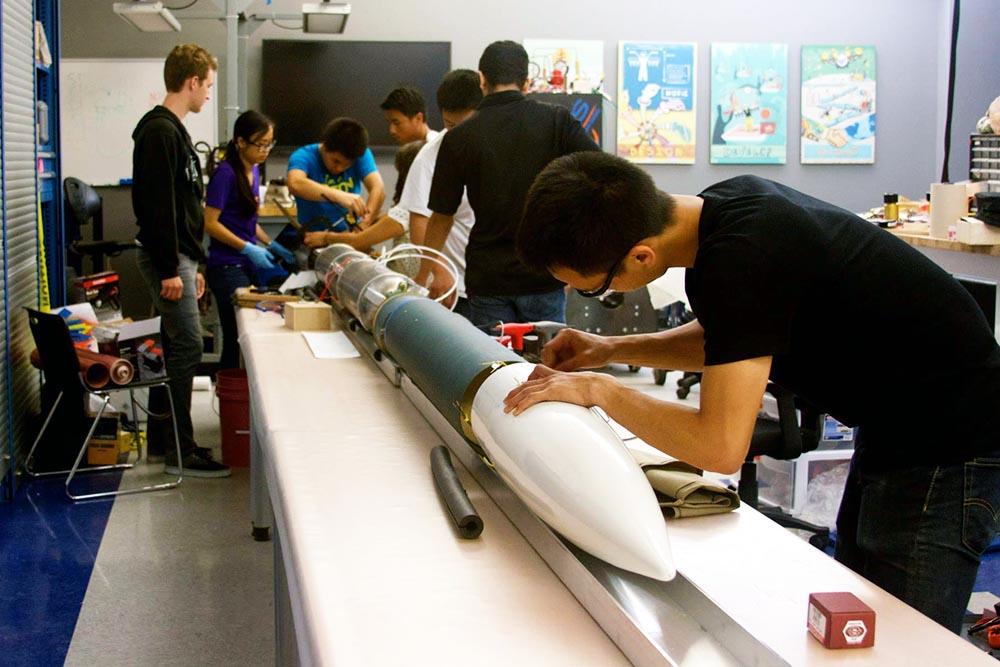Look Out, NASA – Here Comes Vulcan-1! Students Successfully Launch Rocket With Fully 3D Printed Engine
 Sorry, NASA, you’ve been usurped – for the moment, anyway. It’s no secret that the agency has been working towards building a rocket engine made completely from 3D printed parts, and they’re getting very close to completing it. But now someone else has stolen the 3D printed rocket engine thunder – not China, or Russia, but a group of university students from the University of California San Diego. On May 21, the Mojave Desert echoed with the sound of the Vulcan-1 as it lifted off, followed by the ecstatic cheers of the students who had spent long months working to build it and get it off the ground.
Sorry, NASA, you’ve been usurped – for the moment, anyway. It’s no secret that the agency has been working towards building a rocket engine made completely from 3D printed parts, and they’re getting very close to completing it. But now someone else has stolen the 3D printed rocket engine thunder – not China, or Russia, but a group of university students from the University of California San Diego. On May 21, the Mojave Desert echoed with the sound of the Vulcan-1 as it lifted off, followed by the ecstatic cheers of the students who had spent long months working to build it and get it off the ground.
Students for the Exploration and Development of Space (SEDS) is a national nonprofit dedicated to enabling university students to, according to their website, “participate and make an impact in space exploration.” Colleges around the country host chapters of the organization, but the UCSD chapter is the star of the moment. The launch of their 3D printed rocket engine wasn’t just cool, it was historical – according to the student group, they are the first university organization ever to successfully fly and recover a liquid rocket powered by a 3D printed engine.
 The Vulcan-1’s engine, dubbed Ignus, was 3D printed entirely with Inconel 718, and according to the students, it contains an internal structure of “channels and chasms,” which optimize the efficiency of the combustion, that could only be produced through 3D printing. With 750 pounds of thrust and a chamber pressure of 400 PSI, the engine is 8 inches in diameter, 10 inches high, and fueled by liquid oxygen and kerosene RP-1. According to UCSD SEDS, while they’re not yet entirely sure what altitude the Vulcan-1 reached on Saturday, their current estimate is that it got to about 4,000 feet.
The Vulcan-1’s engine, dubbed Ignus, was 3D printed entirely with Inconel 718, and according to the students, it contains an internal structure of “channels and chasms,” which optimize the efficiency of the combustion, that could only be produced through 3D printing. With 750 pounds of thrust and a chamber pressure of 400 PSI, the engine is 8 inches in diameter, 10 inches high, and fueled by liquid oxygen and kerosene RP-1. According to UCSD SEDS, while they’re not yet entirely sure what altitude the Vulcan-1 reached on Saturday, their current estimate is that it got to about 4,000 feet.
The endeavor has been in the works for a long time. The engine was printed in March 2015, and the entire rocket project took, according to UCSD SEDS, “100,000+ collective hours of effort over 3 generations of SEDS team members.” Its construction took place at Open Source Maker Labs, a fabrication lab in nearby Vista, California.
“[The Vulcan-1 project] started in the fall of 2014, where the goal for that year was to design three different injector plates and one combustion chamber, design a static-fire system, and test all three injector plates during the fall and winter quarter. The best injector plate with the best data, we would put that on the rocket,” said Kenneth Benedictos, Engine Team Co-Lead, Officer of Internal Affairs, and a founding member of UCSD SEDS.
“The goal was to have that rocket built and flown in Utah, but that was a really ambitious timeline and we ended up taking a whole year to build the rocket,” Benedictos continued. “After we knew the first injector plate we tested–Ignus–worked, we were able to mount that to the rocket. We tried to design the whole project in one quarter–that obviously didn’t work out, because we started fabricating before we even started designing. That was a big lesson we learned in project engineering–you always have to design and analyze before you can even touch a wrench.”
Several pitfalls happened along the way to getting the Vulcan-1 off the ground, and the launch had to be pushed back a few times, but each setback enabled the students to learn, troubleshoot and perfect the rocket’s design so that it the best it could be at the time of launch. The project doesn’t end here, however. In the future, the UCSD SEDS team is looking to build more powerful engines – the recently launched Vulcan-1 is just a “stepping stone.” And unlike the spent jet fuel, the students are far from burned out.
“It’s crazy to see where everything’s gone,” said Benedictos. “It just started as a group of guys who were friends and all had a similar vision. We all liked to deal with things that combust. So that was cool–it was a small team and with a small team, you wear a lot of hats, kind of like a small company…. But now, after every project we’ve added, we need more designers, engineers, everything, and with the success we’re having, to give us more support and enable us to do more work. Each new project, there’s new members with newfound inspiration and motivation. And it’s like creating a movement, a wave that starts off small and grows into one big movement, one big wave that everyone’s riding.”
Watch the historic launch below (or, to see more footage from the day, you can also check out the full hour-plus-long live stream that was aired as it happened). Discuss further over in the Students 3D Print Rocket Engine forum at 3DPB.com.
[Images: UCSD SEDS/Facebook]
Subscribe to Our Email Newsletter
Stay up-to-date on all the latest news from the 3D printing industry and receive information and offers from third party vendors.
Print Services
Upload your 3D Models and get them printed quickly and efficiently.
You May Also Like
Thrōn made Launches Kickstarter Campaign for 3D Printed Furniture Made with Recycled Material
This month, a small U.S. startup called Thrōn made launched a crowdfunding campaign on Kickstarter for its collection of 3D printed sculptural furniture, with an emphasis on sustainable, eco-friendly solutions....
FibreSeeker 3: The World’s First Continuous Fibre 3D Printer for the Consumer Launches on Kickstarter
For decades, FDM 3D printing has been the go-to technology for makers, engineers, and educators looking to quickly prototype ideas. But while the speed and accessibility of fused deposition modeling...
3D Printing News Briefs, September 6, 2025: SBIR Awards, Regenerative Medicine, & More
In this weekend’s 3D Printing News Briefs, we’ll start with some exciting funding news, as NIST has awarded over nearly $2 million to small businesses working to advance AI, additive...
From Energy to Defense: Strengthening Supply Chains Through Dual-Use Additive Manufacturing
Dual-use technologies serve more than one sector, often bridging the gap between commercial and defense applications. Additive manufacturing (AM), once seen primarily as a prototyping tool, is now maturing into...

































